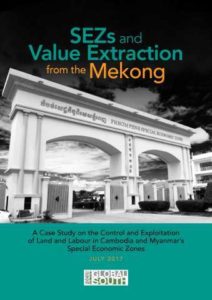19/10/2017
Under: Publications, Trade and Investment
Special Economic Zones (SEZs) have been built worldwide since the 1960s to facilitate global free trade and integrate developing countries into global production and distribution networks, and have been mushrooming in Southeast Asia in recent years. They remain controversial, and are attracting growing interest from policy makers, investors, civil society, and the general public. Supporters praise them for spurring foreign investment, creating jobs, building infrastructure, and helping host countries to diversify their economies; critics argue that they entail more costs than benefits, negatively impact local communities, undermine workers’ rights, and cause environmental harm and degradation. Asking why, and to what end, SEZs are being developed in the Mekong, this study develops two case studies of special economic zones in Cambodia and Myanmar, of the incentives and assurances offered to investors weighed against the protection and benefits to local communities, workers, and the environment.
It finds that SEZs have played a central role in the Greater Mekong Subregion Economic Cooperation Scheme (GMS-ECP) since the mid-1990s, a regional integration and development model of the Asian Development Bank (ADB); and are being integrated into China’s One Belt, One Road initiative. Although generous enticements and guarantees are offered to investors, similar commitments have not been extended to locals. While national and international laws and standards pertaining to land, labour rights, and environmental protection officially apply to SEZs, they have not been implemented effectively. SEZs have been developed with limited transparency and locals have been displaced without proper consultation and adequate redress. Workers face obstacles protecting rights they are entitled to under domestic and international law, and have been violently supressed for asserting them. Environmental impact assessments have not always met international standards, and environmental regulations have been enforced selectively in some zones.
The study concludes that the legislative and governance structures covering the development and operation of SEZs have been skewed toward the interests of investors and against those of locals and the environment. It contends that SEZs have been used as tools enabling investors to capture and exploit Cambodia and Myanmar’s most productive assets, their land and labour, and are facilitating the financial extraction of value from the Mekong. It also suggests that weaknesses in SEZ governance structures, and the lack of transparency and accountability in the development and administration of the zones, are heightening the risk of capture of the state by political and economic elites: whereby public power may be exercised for private gain, and preferential treatment for certain individuals or firms is woven into the institutional framework of a state.
Affirming that SEZs are essentially policy tools that can be wielded to different ends using various means, the study recommends that: 1. SEZ legislative and governance framework be revised to mediate interests of investors and locals more sustainably and fairly; 2. Governments reduce their reliance on foreign investments in land and labour intensive industries, and instead invest in local industries and public infrastructure; 3. Governments meet international standards of transparency and accountability in SEZ investment and governance arrangements to mitigate the threat of capture of the state and minimize further financial extraction of value from the region; 4. Civil society continue to work with communities affected by SEZs and engage with public officials and the private sector, as well as holding misfeasors to account. Civil society could also develop new strategies to deal with more recalcitrant stakeholders, to contribute to a more equitable and liveable region for its inhabitants.






